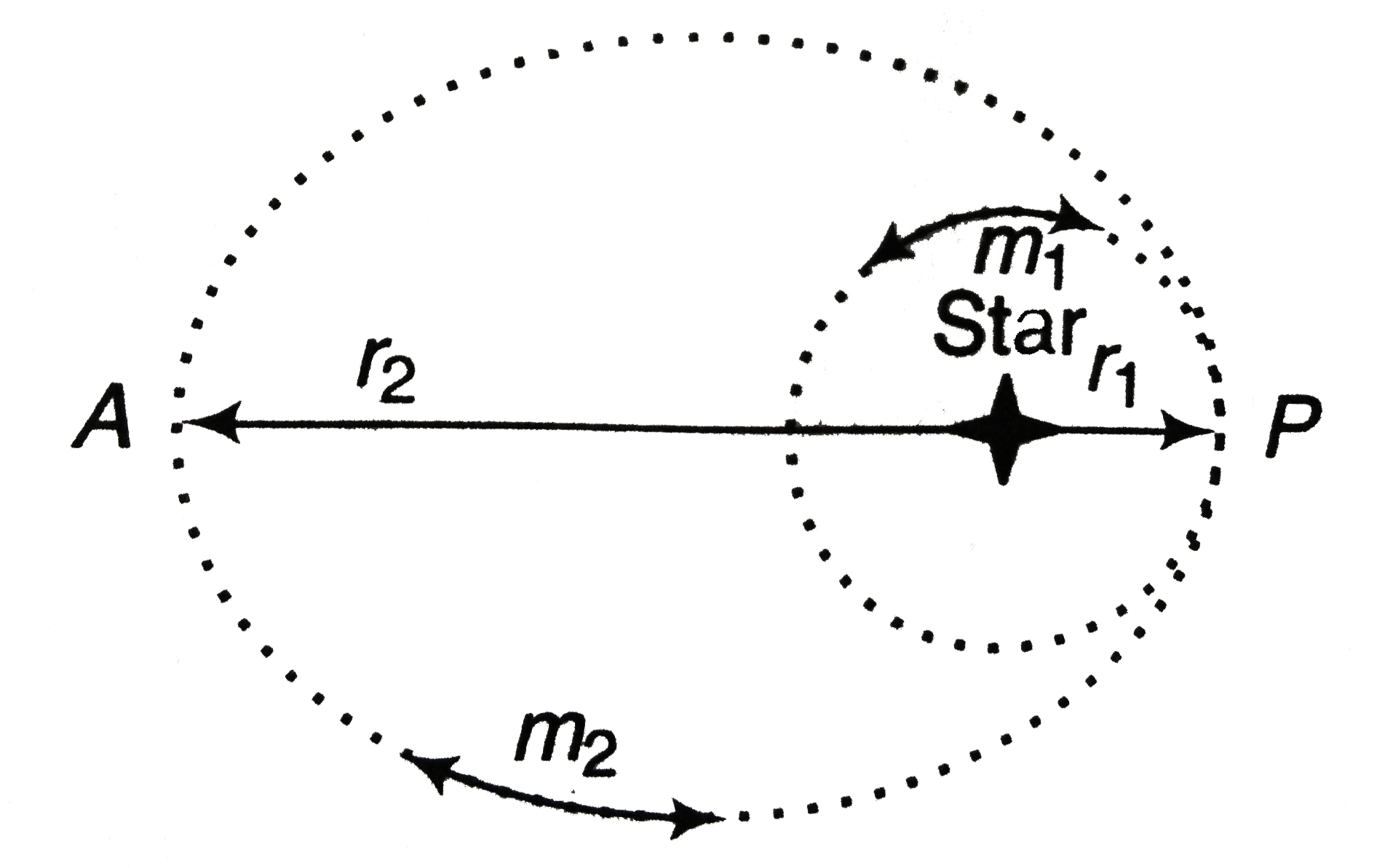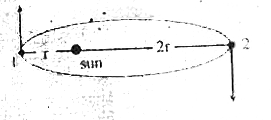The Saturn is about six times farther from the Sun than The Mars Which planet has
(a) the greater period of revolution
(b) the greater orbital speed and (c )the greater angular speed ?
The correct Answer is:(a) The Saturn (b) The Mars (c) The Mars .
To solve the problem, we need to analyze the relationship between the distance of the planets from the Sun and their orbital characteristics based on Kepler's laws of planetary motion.
Given:
- Saturn is about 6 times farther from the Sun than Mars.
- Let the distance of Mars from the Sun be rm.
- Therefore, the distance of Saturn from the Sun is rs=6rm.
(a) Greater Period of Revolution:
According to Kepler's Third Law, the square of the period of revolution T of a planet is directly proportional to the cube of the semi-major axis (orbital radius) of its orbit. Mathematically, this is expressed as:
T2∝r3
This implies:
T∝r3/2
Since Saturn is farther from the Sun than Mars, we have:
rs>rm
Thus, the period of revolution for Saturn will be greater than that of Mars:
Ts>Tm
Conclusion: Saturn has the greater period of revolution.
(b) Greater Orbital Speed:
The orbital speed v of a planet is given by the formula:
v=√GMr
Where:
- G is the gravitational constant,
- M is the mass of the Sun,
- r is the distance from the Sun.
From this formula, we see that the orbital speed is inversely proportional to the square root of the radius:
v∝1√r
Since rs=6rm:
vs∝1√6rm<vm∝1√rm
Thus, the orbital speed of Mars is greater than that of Saturn:
vm>vs
Conclusion: Mars has the greater orbital speed.
(c) Greater Angular Speed:
The angular speed ω is related to the period of revolution by the formula:
ω=2πT
This indicates that angular speed is inversely proportional to the period of revolution:
ω∝1T
Since we established that the period of revolution for Saturn is greater than that for Mars:
Ts>Tm⟹ωs<ωm
Thus, Mars has a greater angular speed than Saturn:
ωm>ωs
Conclusion: Mars has the greater angular speed.
Final Answers:
(a) Saturn has the greater period of revolution.
(b) Mars has the greater orbital speed.
(c) Mars has the greater angular speed.
- Saturn is about 6 times farther from the Sun than Mars.
- Let the distance of Mars from the Sun be rm.
- Therefore, the distance of Saturn from the Sun is rs=6rm.
According to Kepler's Third Law, the square of the period of revolution T of a planet is directly proportional to the cube of the semi-major axis (orbital radius) of its orbit. Mathematically, this is expressed as:
T2∝r3
This implies:
T∝r3/2
Since Saturn is farther from the Sun than Mars, we have:
rs>rm
Thus, the period of revolution for Saturn will be greater than that of Mars:
Ts>Tm
Conclusion: Saturn has the greater period of revolution.
The orbital speed v of a planet is given by the formula:
v=√GMr
Where:
- G is the gravitational constant,
- M is the mass of the Sun,
- r is the distance from the Sun.
v∝1√r
Since rs=6rm:
vs∝1√6rm<vm∝1√rm
Thus, the orbital speed of Mars is greater than that of Saturn:
vm>vs
Conclusion: Mars has the greater orbital speed.
The angular speed ω is related to the period of revolution by the formula:
ω=2πT
This indicates that angular speed is inversely proportional to the period of revolution:
ω∝1T
Since we established that the period of revolution for Saturn is greater than that for Mars:
Ts>Tm⟹ωs<ωm
Thus, Mars has a greater angular speed than Saturn:
ωm>ωs
Conclusion: Mars has the greater angular speed.
(a) Saturn has the greater period of revolution.
(b) Mars has the greater orbital speed.
(c) Mars has the greater angular speed.
Topper's Solved these Questions
- GRAVITATIONBOOK - RESONANCE ENGLISHCHAPTER - GRAVITATIONEXERCISE - EXERCISE-1 PART-2
21 Videos
- GRAVITATIONBOOK - RESONANCE ENGLISHCHAPTER - GRAVITATIONEXERCISE - EXERCISE-1 PART-3
2 Videos
- GRAVITATIONBOOK - RESONANCE ENGLISHCHAPTER - GRAVITATIONEXERCISE - EXAMPLE
2 Videos
- GEOMATRICAL OPTICS BOOK - RESONANCE ENGLISHCHAPTER - GEOMATRICAL OPTICS EXERCISE - Advance level Problems
35 Videos
- NUCLEAR PHYSICSBOOK - RESONANCE ENGLISHCHAPTER - NUCLEAR PHYSICSEXERCISE - Advanced level solutions
16 Videos
Similar Questions
Two planets of equal mass orbit a much massive star (figure). Planet m1 moves in circular orbit of radius 1×108km with period 2yr. Planet m2 moves in an elliptical orbit with closed distance r1=1×108km and farthest distance r2=1.8×108km, as shows.

(a) Using the fact that the mean radius of an elliptical orbit is the length of the semi-major axis, find the period of m2's orbit.
(b) Which planet has the greater speed at point P? Which has the greater total energy?
(c ) Compare the speed of planet m2 at P with that at A.
View SolutionThe distance of the planet Jupiter from the Sun is 5.2 times that of the Earth. Find the period of Jupiter's revolution around the Sun.
View Solution
Knowledge Check
If a planet revolves around the sun in a circular orbit of radius a with a speed of revolution T, then (K being a positive constant
AT=Ka2/3BT=Ka3/2CT=Ka2DT=Ka3Which of the following equations has a graph for which all roots are greater than 0 ?
Ay=4|x|By=x2−4Cy=(x−2)2Dy=x(x−2)2On the second leg of a certain journey, a person traveled at an average speed 50 percent greater than the average speed at which the person traveled the first leg of the journey, and for an amount of time 50 percent greater than the amount of time spent on the first leg of the journey. The person's average speed for the entire journey was what percent greater than the person's average speed on the first leg of the journey ?
A22.5%B25%C30%D50%
A planet of mass m is moving in an elliptical orbit about the sun (mass of sun = M). The maximum and minimum distances of the planet from the sun are r1 and r2 respectively. The period of revolution of the planet wil be proportional to :
View SolutionA solid sphere and a hollow cylinder have the same radius and the same mass. They start from rest at the top of an incline. Which reaches the bottom first? Which has the greater speed at the bottom? Which has the greater total kinetic energy of the bottom ? Which has the greater rotational KE?
View SolutionTwo hypothetical planets 1 and 2 are moving in the same eliptical path as shown in the figure. If the planets are situated at minimum and maximum distance from the sun and one of the planet, say 1, has speed v. Find the relative angular speed of the planets for the given situation.

View SolutionThe variation in the speed of the planet in their orbits about the sun can be explained on the basic of the conservation of :-
View SolutionThe mean distance of Mars from the sun in 1.524 times that of the Earth from the sun. Find the number of years requires for Mars make one revolution about the Sun.
View Solution
